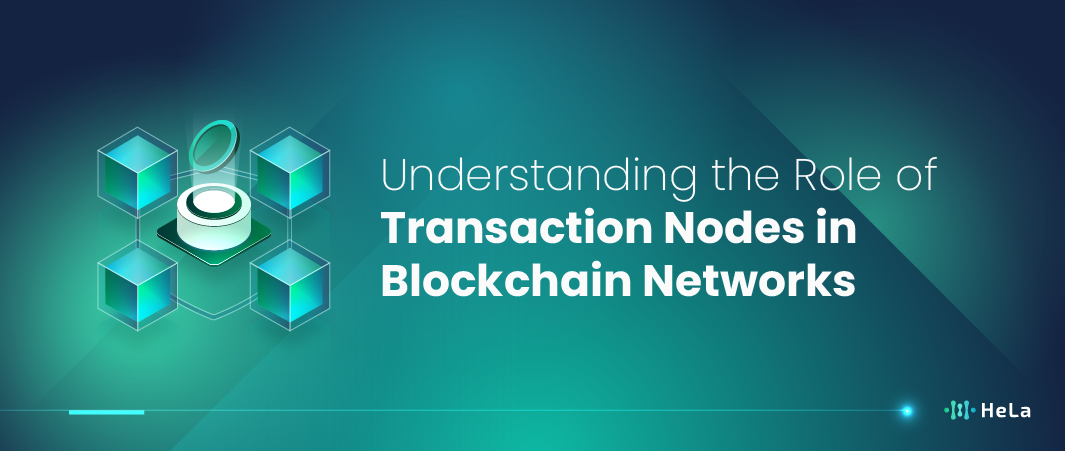When discussing blockchain and distributed ledger technologies, a transaction node is considered the core construct since it is an object directly involved in processing, validation, and recording transactions within the network. All these participants work and function autonomously within the system but in a synchronized manner that is responsible for maintaining the authenticity, blockchain, and confidentiality of the block by performing validation tests on every transaction before it is incorporated into the block. These nodes have an exact copy of the blockchain that contains all the transactions, it makes the management of the system decentralized and contingency plans in the case of failure of the nodes are rare.
Transaction nodes are beneficial in the aspects of scalability and fault tolerance when implemented in blockchain systems. The rationale for this idea is that as more nodes operate in a network, this tends to make the network as a whole to be more secure from attacks and failures that may occur. These nodes ensure that the database is decentralized, and in the event that a number of nodes are out of reach or are malicious, the blockchain can still function as required. Moreover, the transaction nodes allow not only processing financial or other types of transactions but also smart contracts and decentralized applications implementation, or dApps. Read more below to know more.
What is Transaction Node?

A transaction node is a node within a network or a system responsible for the coordination and execution of transactions. It serves as a contact interface where activities, including data processing, validation, or transfer, take place. In distributed ledger technologies such as Bitcoin blockchain, a transaction node is essential in the validation and writing of transactions. These nodes guarantee that every transaction follows the protocol standard, thus enhancing the safety of data being processed.
Transaction nodes have several important tasks. They get transaction data, check the validity and then relay the data to other nodes within the network. Once the transaction has been approved by the consensus mechanism of the network, then it is added to the ledger, making it virtually unalterable. Through this process involving multiple nodes, it becomes possible to have a decentralized and immutably secured ledger.
Functions of Transaction Nodes
Transaction nodes are a significant type of node that is used within decentralized systems, especially the sphere of blockchain. Some of the functions that are carried out include: validation of the transactions and security of the network. All of them are crucial to provide trustworthiness and accuracy for a blockchain environment. Here’s a detailed breakdown of their roles:
Transaction Validation
In overview, it can be stated that one of the major activities performed by the transaction nodes is the validation of transactions. This process involves a check for the validation of every transaction in question in regards to the digital signatures of the transaction. Transaction nodes apply intricate security measures based on the complexity of the cryptographic algorithms in order to ascertain the validity of signatures and to confirm that the sender possesses enough credits to perform the transaction.
Also Read: What Is Steem?
This validation process is important due to the complexity of the growing system and its integration to minimize cases of fraud, particularly the instance of double spending within the network. It ensures that all nodes in the blockchain are acting in good faith and thus must uphold the trust of each transaction.
Network Security
Transaction nodes are scrutinized in ensuring that the security of the blockchain is upheld throughout this type of setting. They also contribute during the validation of blocks, creation of new blocks, consensus determining, and distribution of blocks, effectively shielding the network from different attacks. For example, the validation process may eliminate the possibility of multiple spending of the same crypto since the invention of double-spending is inevitable in blockchain technology.
On the other hand, the consensus mechanisms protect the blockchain history from being modified. Furthermore, the transaction broadcasting process allows various nodes to perform this action independently and ensures that efforts to manipulate or disrupt the operation of the network will not succeed. In this way, transaction nodes allow for creating a more favorable and safe block chain environment as they perform the specified functions.
Importance of Transaction Nodes

Transaction nodes are critical in many systems and also in the field of blockchain and distributed systems. They are equally valuable in so many aspects as a characteristic that contributes to the strength, security and rapidity of these networks. Here’s a detailed exploration of the importance of transaction nodes:
Validation and Verification
The transaction nodes are crucial to the validation or verification of transactions in a network. When a transaction is being made in a blockchain, it is distributed to several nodes that are in a network. Such nodes individually confirm by approving the given transaction code as per the laid down set of rules.
This process enables the transaction to be genuine, and it implies that the transaction comes from the right or legal source and meets the protocol requirements. For instance, in Bitcoin, nodes confirm that the subject sending money has enough balance and has the right signature of transactions. This feature slows down double-spend and other fraudulent activities, thus ensuring the reliability and effectiveness of the evaluated network.
Decentralization
Decentralization is one of the defining principles of blockchain technology, and transaction nodes are intentionally logical. Decentralized are in a decentralized system, data and decision-making powers are spread across several nodes instead of being concentrated in an organization or administrative center.
These distributions contribute to improved security and minimized vulnerability of system failure. Encryption is distributed across the network such that if one node falls prey to an attacker or stops working, the others are still able to function. This decentralization is very important because no single point controls the entire system making the network non-censorable and immune to any form of manipulation.
Transaction Propagation
Transaction propagation is another function of the transaction nodes and should be efficient. When a transaction is created it needs to be propagated in the network and validated in a very short span of time to come to a consensus. Nodes transmit transactions by passing them to the next node in the network and then forwarded again.
Through this propagation process, transactions are disseminated widely across the network to all nodes as quickly as possible which is very essential in enhancing the efficiency of the network. Efficient propagation prevents delay in the process of forwarding as well as confirmation of transactions.
Security and Resilience
The decentralized nature of transaction nodes additionally strengthens the security and stability of the blockchain systems. By having a copy of the data stored across the network nodes, the network becomes less susceptible to attacks and failures.
It is important to understand that an attacker would need to have control over a significant number of nodes in the network in order to compromise a blockchain and this is normally very costly both in terms of computational power and money. This security feature, known as Byzantine fault tolerance, guarantees that the network will keep operating as expected even if some nodes act maliciously or don’t work at all.
Transparency and Trust
It is a fact that blockchain technology relies on transparency and trust and transaction nodes are core to these aspects. It is a distributed database where each node keeps a full record of all the transactions, and they are not hidden from any participant.
This also increases the level of trust of the users within the network since they can check for themselves whether the rules are being adhered to. The adaptability of the blockchain since one cannot change what has been done further increases trust because all the transactions have a record of integrity.
Transaction Node Challenge

These are some of the most critical starting points of a decentralized ecosystem, such as blockchain networks, face numerous adversities as they seek to accomplish the goals of completing transactions optimally, securely, and at scale. One of these issues is never to be entirely left behind and that is the problem of scalability. When more and more blockchain networks gain more popularity and acceptance by users, transaction nodes are faced with the challenges of handling increased volumes of transactions while balancing on processing speed and cost.
This requires searching for and applying new mechanisms like sharding, off-chain scaling solutions, and second-tier solutions, which are designed to function at a separate level and distribute transaction workloads across the network as effectively as possible.
Furthermore, security remains a constant consideration for transaction nodes due to their function of ensuring the authenticity of the transaction while simultaneously being responsible for the creation of a new block. While the threats started with hacking attempts and malicious actors who sought to intercept messages being transmitted, there is also a reality in the actual design of the network that must be constantly looked at by transaction nodes.
Elements like a strong security framework, use of better encryption algorithms, multi-factor authentication, and most importantly, better consensus mechanisms shall remain key values to make sure that the sanctity of people’s assets are not compromised and the transactions remain secure.
Besides scaling and securing, the need to ensure business transactions are processed at all times means that the focus is firmly on availability and uptime. Transaction nodes must have some level of protection from potential interruption, stemming from technical hitches, traffic jams, and malicious persons. This requires the establishment of strong physical structures, backup systems, and contingency measures that will enable the network to run endlessly and without any interruption, making a big leap towards increase in its reliability and credibility.
Also Read: What Is A Seed Phrase?
Second, it is also about the relations between decentralization and centralization at the transaction level, and how every node can become as independent as possible while synthesizing coordinated actions for the nodes and achieving the consensus of the entire network. Openness, decentralization increases reliability, censorship resistance and trust in the network while at the same time it brings problems in organization, decision-making and governance.
In doing so, these transaction nodes must successfully cope with these dynamics and intricacies employing decentralized governance structures, community involvement, and consensual methods that should correspond with the network’s requirements.
Conclusion
Transaction nodes emerge as crucial components in the complex structure of advanced networks, providing considerable control of interactions and exchanges. These nodes represent a comprehensive chain that has been set up precisely to model the interactions of transactions in cyberspace. In their essence, transaction nodes act as the actual directors of information movement, maintaining unity and cohesion in databases and networks alike.
They are equally versatile and they cover many responsibilities that include processing of transactions, maintenance of data integrity as well as control of concurrency. Transaction nodes are very sensitive and careful in initiating, verifying, and concluding transactions through algorithms and protocols that minimize errors or inconsistencies that may hinder the efficiency of this system. At the same time, they act as custodians of data, ensuring rigorous compliance with the principles of atomicity, consistency, isolation, and durability required for transaction processing.
The notion of transaction nodes remains relevant in many spheres and proves to be a vital component of contemporary digital landscapes. In the financial world these nodes are the engine driving fast and safe financial transactions helping guarantee financial organizations are always reliable and trustworthy. In the context of e-commerce they enable smooth transactions between the consumer and producers helping millions of customers worldwide to have a smooth purchase experience. Furthermore, in the area of managing databases, the transaction nodes serve as the protectors of the data, keeping the data sacred from being corrupted by the interactions and simultaneous requests.
Disclaimer: The information provided by HeLa Labs in this article is intended for general informational purposes and does not reflect the company’s opinion. It is not intended as investment advice or a recommendation. Readers are strongly advised to conduct their own thorough research and consult with a qualified financial advisor before making any financial decisions.

